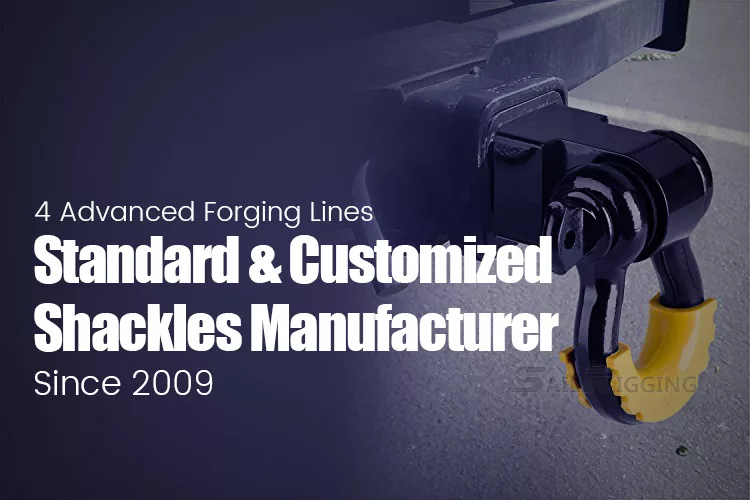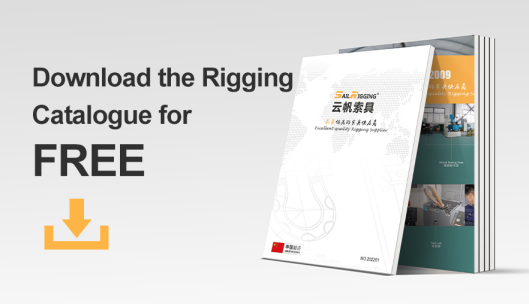How to Choose A Tow Shackle?
Whether you’re an off-road enthusiast or a professional recovery company, whether you’re navigating mud, rocks, or steep slopes, whether you’re using an off-road vehicle or an RV, a trailer shackle is a crucial piece of recovery equipment. Choosing the right, high-quality trailer shackle provides a secure connection for vehicle recovery. Using the wrong size or a low-quality shackle can cause the shackle to break under the load, resulting in damage or serious injury. Therefore, today we’ll discuss tow shackles in depth and how to choose the right one.
Table of Contents
What is a Tow Shackle?
A tow shackle, also called trailer shackle, recovery shackle, is typically a sturdy U-shaped metal ring with a pin that connects recovery straps, pulleys, and other recovery equipment to a vehicle or anchor point. They play a critical role in safely freeing a stuck vehicle from a difficult situation and evenly distributing force during the rescue.

Important Factors to Consider When Choosing Tow Shackle Size
-
Working Load Limit (WLL)
The Working Load Limit (WLL) is a key shackle specification. It serves as a built-in safety factor and represents the maximum force the shackle is designed to safely withstand. This differs from its breaking strength, which is much higher. You should never exceed the WLL of any rigging equipment.
Generally speaking, the Working Load Limit (WLL) should be greater than the weight of the truck. The breaking strength/ultimate load capacity is typically 4-6 times the WLL. When purchasing a tow shackle, it’s important to distinguish between the Working Load Limit and the breaking strength. Some tow shackles are marked with the breaking strength, while others are marked with the WLL.
For example, an 11mm D-type shackle has a Working Load Limit (WLL) of 1500 kg. This chain has a maximum lifting capacity of 1500 kg. In towing applications, since the breaking load is typically 6 times the WLL, it can effectively carry towing loads exceeding 6,000 kg. Our recommended D-type shackle for RVs is based on the chain diameter and ensures that the breaking strain exceeds the chain rating.
-
Vehicle Weight and Size: What Size Shackle for Towing?
The choice of a trow shackle is determined by the ratio of vehicle weight to the shackle’s Working Load Limit (WLL). Vehicle weight and size directly impact the load capacity required for the recovery shackle. Larger vehicles, such as trucks and SUVs, typically require heavier shackles to withstand the increased stresses generated during recovery. Never select a shackle with a WLL lower than the gross vehicle weight, as this allows for additional safety margin in the event of a vehicle becoming stuck. The following are common shackle sizes for common vehicles.
| Type Of Vehicles | Size Of Shackle |
| Large Trucks and Utility Vehicles | 7/8 |
| Full-Size Trucks, Jeeps, and SUVs | 3/4 |
| Small Trucks, UTVs, Side-by-Side Pickups, and Powersports Vehicles | 5/8 & 1/2 |
-
Shackle Material and Strength
Recovery shackles are typically made of carbon steel with alloy steel cross pins. These shackles are known for their durability and strength and are a popular choice for heavy-duty applications. Some are made entirely of alloy steel. The specific shackle size depends on the shackle’s weight rating, your vehicle’s needs, and its intended use.
-
Shackle Diameter
Both D-type and bow-shaped shackles can be used for towing. D-type shackles are suitable for straight-line towing, while bow-shaped shackles, with their rounded design, are more suitable for towing at various angles and are commonly used in off-road rescue operations. The diameter of the body (lower portion) of a standard anchor shackle determines its load capacity. Shackles with larger diameters generally have higher load ratings and strength, providing an additional margin of safety during rescue operations. When selecting a tow shackle, consider the vehicle manufacturer’s diameter requirements and the vehicle’s weight.
-
Trapped Vehicle Weight and Working Load Limit (WLL) Considerations
When a truck is stuck in deep mud, the pulling force required to free it is significantly greater than the truck’s own weight. This means that the weight of the vehicle itself can differ significantly from the weight of the vehicle stuck in deep sand, mud, or rock. Due to the resistance of the surrounding terrain, its effective weight is dramatically increased. Soft ground or increased resistance from the terrain effectively increases the vehicle’s weight, making rescue operations more difficult. A winch, safety belt, or towing aids may be required to safely free the vehicle. In this case, you should choose a shackle with a WLL that is at least 3-4 times the vehicle’s gross vehicle weight (GVW) to provide a safety buffer against the added stress of the extrication. The following is a rough guide to vehicle GVWs for your reference.
| Type Of Vehicles | GVW (lbs) | Recommended Shackle WLL (T) |
| Mid-Size SUV | 5,000 | 7.5-10 |
| Full-Size Truck | 7,500 | 11-15 |
| Heavy-Duty Truck | 10,000 | 15-20 |
-
Evaluate the shackle pin size and measure the bumper or tow point hole
The shackle pin diameter is typically larger than the shackle body diameter. Specific dimensional differences may vary depending on the shackle’s design, intended use, and manufacturer specifications. Generally speaking, the pin diameter is typically approximately 15% or ⅛ inch larger than the shackle’s nominal size or the shackle body diameter. A larger pin diameter provides greater surface area, helping to more effectively distribute the load and reducing the risk of pin breakage or bending, thereby enhancing the shackle’s overall strength and reliability during recovery operations. Therefore, before purchasing a trailer shackle, be sure to accurately measure the diameter of the pin hole on your vehicle’s bumper or tow point.
The chart below shows the shackle pin diameters and test bolt sizes:
| Size Of Shackle | Size Of Pins | Test Bolt Size |
| ⅞ Inch Shackle | 1.0 Inch | 1.0-inch to 8-inch, partially threaded |
| 3/4 Inch Shackle | ⅞ Inch pin diameter | ⅞-inch to 9-inch, partially threaded |
| 5/8 Inch Shackle | ¾ inch pin diameter | ¾-inch to 10-inch, partially threaded |
| 1/2 Inch Shackle | ⅝ inch pin diameter | ⅝-inch to 11-inch, partially threaded |
Conclusion
Choosing the right size trailer shackle is crucial for off-road adventures, ensuring both unforgettable moments and peace of mind and minimizing risk. If you want to know more about tow shackle, please consult Sail Rigging right now.





